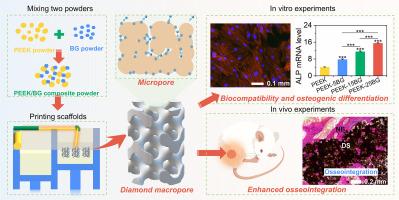激光粉末床熔融打印具有双尺度孔隙的聚醚醚酮/生物活性玻璃复合材料支架,用于增强骨结合和骨生长。
IF 9.4
1区 医学
Q1 ENGINEERING, BIOMEDICAL
引用次数: 0
摘要
虽然聚醚醚酮(PEEK)植入物具有重要的医疗前景,但其生物惰性给临床骨结合和骨生长带来了挑战。为了缓解这些挑战,本研究采用激光粉末床融合(LPBF)技术,精确制造出具有宏观/微观双孔结构的金刚石聚醚醚酮/生物活性玻璃(BG)复合支架。研究结果表明,这些支架中生物活性玻璃含量的增加可显著提高其亲水性和羟基磷灰石形成能力。应力-应变曲线分析表明,所有类型的支架都具有可靠的承重稳定性。体外评估证实了 PEEK/BG 样品的无毒性,并表明随着 BG 含量的增加,成骨分化和矿化也得到了改善。此外,体内实验表明,这些支架的菱形多孔结构有利于骨生长,随着 BG 含量的增加,这种效果明显增强。特别是在含有 15 wt% 和 25 wt% BG 的支架组中,不仅在金刚石结构的大孔中,而且在支架杆内部的微孔中都观察到了新骨的形成,这表明与新骨几乎实现了无缝融合。这表明支架具有有效的骨整合和骨生长特性。这项研究最终确定了通过 LPBF 制作的金刚石结构 PEEK/BG 复合支架在骨修复中的有效性。它强调了 BG 通过与支架的宏观/微观孔相互作用,在增强成骨潜能方面的关键作用。意义说明:本研究通过激光粉末床融合技术开发了金刚石结构的 PEEK/生物活性玻璃(BG)复合支架,解决了 PEEK 植入物的生物惰性问题。这种双孔宏观/微观结构增强了亲水性和羟基磷灰石的形成,对骨再生至关重要。通过调整 BG 含量,我们控制了熔体粘度和烧结速率,从而形成了有益的微尺度孔隙。这些孔隙解决了以往 LPBF 制成的支架中生物活性填料无效的问题,增强了 BG 的成骨潜能,诱导了良好的骨生长和骨整合。体外和体内分析表明,成骨分化、矿化和骨生长都得到了增强,这凸显了这些支架在骨修复方面的临床潜力。本文章由计算机程序翻译,如有差异,请以英文原文为准。

Laser powder bed fusion printed poly-ether-ether-ketone/bioactive glass composite scaffolds with dual-scale pores for enhanced osseointegration and bone ingrowth
Although poly-ether-ether-ketone (PEEK) implants hold significant medical promise, their bioinert nature presents challenges in osseointegration and bone ingrowth within clinical contexts. To mitigate these challenges, the present study introduces Diamond PEEK/bioactive glass (BG) composite scaffolds, characterized by macro/micro dual-porous structures, precisely fabricated via laser powder bed fusion (LPBF) technology. The findings indicate that an increase in BG content within these scaffolds significantly augments their hydrophilicity and hydroxyapatite formation capacities. Stress-strain curve analysis demonstrates reliable load-bearing stability across all scaffold types. In vitro assessments confirmed the non-cytotoxicity of PEEK/BG samples and demonstrated improved osteogenic differentiation and mineralization with increased BG incorporation. Further, in vivo experiments illustrated that the Diamond porous structure of these scaffolds facilitated bone growth, an effect notably amplified with higher BG content. Particularly in groups with 15 wt.% and 25 wt.% BG scaffolds, new bone formation was observed not only within the macropores of the Diamond structure but also within the micropores inside the scaffold rod, suggesting an almost seamless fusion with the new bone. This demonstrates the scaffolds’ effective osteointegration and bone ingrowth properties. This study conclusively established the effectiveness of Diamond-structured PEEK/BG composite scaffolds, fabricated via LPBF, in bone repair. It highlights the crucial role of BG in enhancing osteogenic potential through interaction with the macro/micro pores of the scaffold.
Statement of significance
This study addresses the bioinert nature of PEEK implants by developing Diamond-structured PEEK/bioactive glass (BG) composite scaffolds by laser powder bed fusion. The dual-porous macro/microstructure enhances hydrophilicity and hydroxyapatite formation, vital for bone regeneration. By adjusting the BG content, we controlled the melt viscosity and sintering rate, leading to the formation of beneficial microscale pores. These pores resolve the issue of ineffective bioactive fillers in previous LPBF-fabricated scaffolds, enhancing the osteogenic potential of BG and inducing superior bone ingrowth and osseointegration. In vitro and in vivo analyses show enhanced osteogenic differentiation, mineralization, and bone growth, underscoring the clinical potential of these scaffolds for bone repair.
求助全文
通过发布文献求助,成功后即可免费获取论文全文。
去求助
来源期刊

Acta Biomaterialia
工程技术-材料科学:生物材料
CiteScore
16.80
自引率
3.10%
发文量
776
审稿时长
30 days
期刊介绍:
Acta Biomaterialia is a monthly peer-reviewed scientific journal published by Elsevier. The journal was established in January 2005. The editor-in-chief is W.R. Wagner (University of Pittsburgh). The journal covers research in biomaterials science, including the interrelationship of biomaterial structure and function from macroscale to nanoscale. Topical coverage includes biomedical and biocompatible materials.
 求助内容:
求助内容: 应助结果提醒方式:
应助结果提醒方式:


